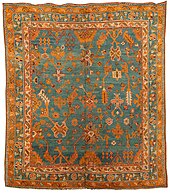Rugs from Turkey

Turkish carpet


Oushak (Usak) carpet (late 19th century)
Turkish carpets (also known as Anatolian), whether hand knotted or flat woven, are among the most well known and established hand crafted art works in the world.Historically: religious, cultural, environmental, sociopolitical and socioeconomic conditions created widespread utilitarian need and have provided artistic inspiration among the many tribal peoples and ethnic groups in Central Asia and Turkey. Turks; nomadic or pastoral, agrarian or town dwellers, living in tents or in sumptuous houses in large cities, have protected themselves from the extremes of the cold weather by covering the floors, and sometimes walls and doorways, with carpets and rugs. The carpets are always hand made of wool or sometimes cotton, with occasional additions of silk. These carpets are natural barriers against the cold. Turkish pile rugs and kilims are also frequently used as tent decorations, grain bags, camel and donkey bags, ground cushions, oven covers, sofa covers, bed and cushion covers, blankets, curtains, eating blankets, table top spreads, prayer rugs and for ceremonial occasions.
The oldest records of flat woven kilims come from Çatalhöyük Neolithic pottery, circa 7000 B.C. One of the oldest settlements ever to have been discovered, Çatalhöyük is located south east of Konya in the middle of the Anatolian region.The excavations to date (only 3% of the town) not only found carbonized fabric but also fragments of kilims painted on the walls of some of the dwellings. The majority of them represent geometric and stylized forms that are similar or identical to other historical and contemporary designs.
The knotted rug is believed to have reached Asia Minor and the Middle East with the expansion of various nomadic tribes peoples during the latter period of the great Turkic migration of the 8th and 9th centuries. Famously depicted in European paintings of The Renaissance, beautiful Anatolian rugs were often used from then until modern times, to indicate the high economic and social status of the owner.
Women learn their weaving skills at an early age, taking months or even years to complete the beautiful pile rugs and flat woven kilims that were created for their use in every aspect of daily life. As is true in most weaving cultures, traditionally and nearly exclusively, it is women and girls who are both artisan and weaver.



